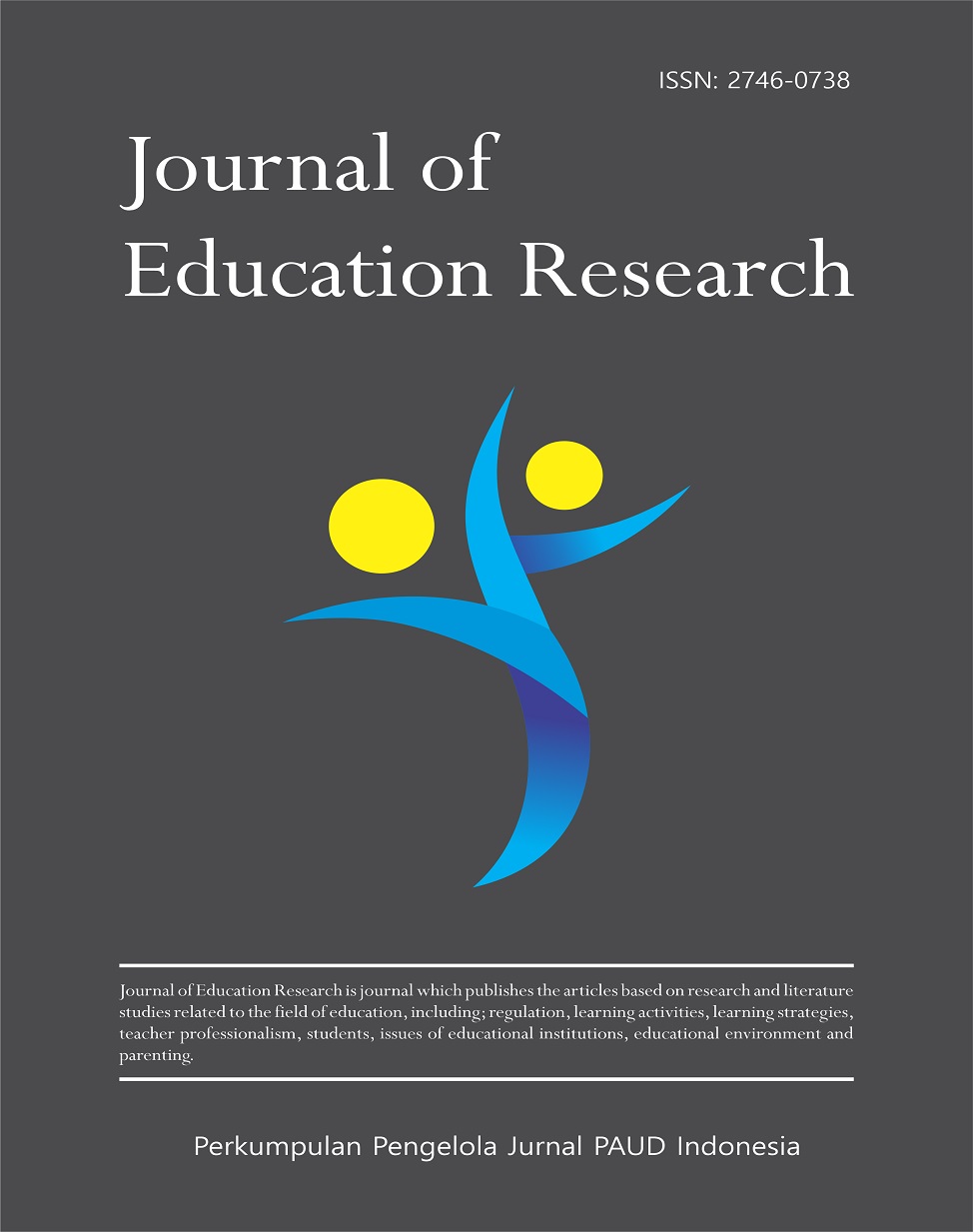Curriculum Models in Gifted Education: A Comparative Study for 21st-Century Schools
DOI:
https://doi.org/10.37985/jer.v6i4.2885Keywords:
Curriculum model, gifted education, enrichment, talent development, curriculum differentiationAbstract
The field of gifted education continually seeks effective pedagogical frameworks to foster the intellectual growth, creativity, and socio-emotional development of advanced learners. While numerous curriculum models exist, a comprehensive comparative analysis addressing their practical application and implications for diverse gifted populations remains underexplored. This study addresses this gap by conducting a comparative literature review of prominent curriculum models in gifted education, including the Enrichment Triad Model, Parallel Curriculum Model, Autonomous Learner Model, Maker’s Curriculum Modification Model, The Purdue Three-Stage Model, School-wide Enrichment Model, Talent Search Model, Grid: Depth and Complexity Model, Multiple Menu Model, Integrated Curriculum Model, and Talent’s Unlimited Model. By systematically examining their key features, underlying principles, target learners, and inherent strengths and limitations, this research provides a timely and necessary resource for educators and policymakers. The findings underscore the imperative of aligning curriculum model selection with established gifted education principles and highlight the crucial roles of teachers, parents, gifted learners, and other school stakeholders in this decision-making process. Ultimately, this comparative analysis aims to guide practitioners in making informed choices that maximize student potential and optimize educational outcomes within varied gifted education context. The paper concludes by underscoring the importance of aligning curriculum model selection with gifted education principles and considering the roles of teachers, parents, gifted learners, and other school stakeholders in the decision-making.
Downloads
References
Alqahtani, R., & Kaliappen, N. (2020). Quality assurance in gifted education. Universal Journal of Educational Research, 8(11), 5137–5144. https://doi.org/10.13189/ujer.2020.081113
Andini, D. W., Rahayu, A., Budiningsih, C. A., & Mumpunıartı, M. (2020). The curriculum adaptation model in fulfilling the learning need for diverse students at inclusive classroom. Universal Journal of Educational Research, 8(11), 6091–6097. https://doi.org/10.13189/ujer.2020.081716
Azano, A. P., Callahan, C. M., Bass, E. L., & Rasheed, M. (2020). Supporting gifted education in rural schools. The Rural Educator, 41(2), 47–56. https://doi.org/10.35608/ruraled.v41i2.851
Azano, A. P., Callahan, C. M., Brodersen, A. V., & Caughey, M. (2017). Responding to the challenges of gifted education in rural communities. Global Education Review, 4(1), 62–77. https://files.eric.ed.gov/fulltext/EJ1137994.pdf
Bailey, R., & Morley, D. (2006). Towards a model of talent development in physical education. Sport, Education and Society, 11(3), 211–230. https://doi.org/10.1080/13573320600813366
Betts, G. T., Carey, R. J., & Kapushion, B. M. (2021). The autonomous learner model. In Developing autonomous learners (pp. 91–110). Routledge. https://doi.org/10.4324/9781003235262-5
Betts, G. T., & Neihart, M. (1986). Implementing self-directed learning models for the gifted and talented. Gifted Child Quarterly, 30(4), 174–177. https://doi.org/10.1177/001698628603000406
Brigandi, C. B., Gilson, C. M., & Miller, M. (2019). Professional development and differentiated instruction in an elementary school pullout program: A gifted education case study. Journal for the Education of the Gifted, 42(4), 362–395. https://doi.org/10.1177/0162353219874418
Brulles, D., & Winebrenner, S. (2011). The schoolwide cluster grouping model. Gifted Child Today, 34(4), 35–46. https://doi.org/10.1177/1076217511415381
Chan, D. (2015). Education for the gifted and talented. In J. D. Wright (Ed.), International encyclopedia of the social & behavioral sciences (pp. 158–164). Elsevier. https://doi.org/10.1016/b978-0-08-097086-8.92137-8
Chandra, D. V. (2020). Extending Renzulli’s Enrichment Triad Model in education for gifted and talented learners within an inclusive classroom context. [Unpublished manuscript].
Cheung, A., Shek, D. T. L., Hui, A. N. N., Leung, K. H., & Cheung, R. S. H. (2022). Professional development for teachers of gifted education in Hong Kong: Instrument validation and training effectiveness. International Journal of Environmental Research and Public Health, 19(15), 9433. https://doi.org/10.3390/ijerph19159433
Ford, D. Y., Davis, J. L., Whiting, G. W., & Moore, J. L. (2021). Going beyond lip service when it comes to equity: Characteristics of equity-minded, culturally responsive allies in gifted and talented education. Gifted Child Today, 44(3), 174–183. https://doi.org/10.1177/10762175211011210
García‐Martínez, I., Cáceres, R. G., Rosa, A. L. de la, & León, S. P. (2021). Analysing educational interventions with gifted students: Systematic review. Children, 8(5), 365. https://doi.org/10.3390/children8050365
Göksu, D. Y., & Gelişli, Y. (2023). Differentiation models for the curriculum of gifted and talented individuals: A literature review. International Journal of Educational Research Review, 8(2), 268–281. https://doi.org/10.24331/ijere.1227783
Haddaway, N. R., Page, M. J., Pritchard, C. C., & McGuinness, L. A. (2022). PRISMA2020: An R package and Shiny app for producing PRISMA 2020-compliant flow diagrams, with interactivity for optimised digital transparency and open synthesis. Campbell Systematic Reviews, 18(2), e1230. https://doi.org/10.1002/cl2.1230
Hernández, D., & Saranlı, A. G. (2014). A cross-cultural perspective about the implementation and adaptation process of the schoolwide enrichment model. Gifted Education International, 31(3), 257–276. https://doi.org/10.1177/0261429414526335
Hertzog, N. B., Lamb, K. N., & Balatico, A. J. (2023). School district equity initiatives that impact access to accelerated and advanced learning. Gifted Child Quarterly, 67(4), 325–341. https://doi.org/10.1177/00169862231186669
Hu, M. I. M., Horng, J., & Teng, C. (2016). Developing a model for an innovative culinary competency curriculum and examining its effects on students’ performance. The Journal of Creative Behavior, 50(3), 193–204. https://doi.org/10.1002/jocb.139
Jenkins‐Friedman, R. (1983). Self-directed learning for educators of gifted and talented students: Teachers need it, too! Journal for the Education of the Gifted, 5(2), 104–112. https://doi.org/10.1177/016235328300500205
Johnsen, S. K. (2024). Finding talent: An overview of research about best practices in identification. Education Sciences, 14(9), 1027. https://doi.org/10.3390/educsci14091027
Kaplan, S. N. (1981). [Review of Curriculum Development for the Gifted]. Journal for the Education of the Gifted, 5(4), 315–316. https://doi.org/10.1177/016235328100500411
Kaplan, S. N. (2007). Classics curriculum: A focus to differentiated curriculum. Gifted Education International, 23(1), 15–23. https://doi.org/10.1177/026142940702300104
Kerr, B. (2009). Parallel curriculum model. In B. Kerr (Ed.), Encyclopedia of giftedness, creativity, and talent (pp. 678–681). SAGE. https://doi.org/10.4135/9781412971959.n286
Maker, C. J. (1986). Suggested principles for gifted preschool curricula. Topics in Early Childhood Special Education, 6(1), 62–69. https://doi.org/10.1177/027112148600600109
Moller, B. W. (1986). A developmental model for a gifted program using Renzulli’s Enrichment Triad. G/C/T, 9(2), 11–15. https://doi.org/10.1177/107621758600900206
Moon, S. M. (1996). Using the Purdue three-stage model to facilitate local program evaluations. Gifted Child Quarterly, 40(3), 121–129. https://doi.org/10.1177/001698629604000302
Moon, S. M., Feldhusen, J. F., & Dillon, D. R. (1994). Long-term effects of an enrichment program based on the Purdue three-stage model. Gifted Child Quarterly, 38(1), 38–48. https://doi.org/10.1177/001698629403800106
Oh, S. S., Hailey, E., Azano, A. P., Callahan, C. M., & Moon, T. R. (2012). What works in gifted education: Documenting the model-based curriculum for gifted students. Society for Research on Educational Effectiveness. https://eric.ed.gov/?id=ED535658
Olenchak, F. R. (1990). School change through gifted education: Effects on elementary students’ attitudes toward learning. Journal for the Education of the Gifted, 14(1), 66–78. https://doi.org/10.1177/016235329001400108
Olszewski‐Kubilius, P. (1998). Talent search. Journal of Secondary Gifted Education, 9(3), 106–110. https://doi.org/10.1177/1932202x9800900303
Pahrudin, A., Syafril, S., Erlina, N., Saputri, A., & Fitriani, F. (2024). Adaptive learning models for gifted and talented students: Global perspectives and implementation challenges. Tadris: Jurnal Keguruan dan Ilmu Tarbiyah, 9(2), 543–559. https://doi.org/10.24042/tadris.v9i2.24754
Pawilen, G. T., & Manuel, S. J. (2018). A proposed model and framework for developing a curriculum for the gifted in the Philippines. International Journal of Curriculum and Instruction, 10(2), 118–134. http://files.eric.ed.gov/fulltext/EJ1207237.pdf
Peters, S. J. (2021). The challenges of achieving equity within public school gifted and talented programs. Gifted Child Quarterly, 66(2), 82–101. https://doi.org/10.1177/00169862211002535
Rawl, R. K., & O’Tuel, F. S. (1983). Information processing theories and the education of the gifted. Roeper Review, 6(2), 83–85. https://doi.org/10.1080/02783198309552764
Reis, S. M., & Peters, P. M. (2020). Research on the schoolwide enrichment model: Four decades of insights, innovation, and evolution. Gifted Education International, 37(2), 109–129. https://doi.org/10.1177/0261429420963987
Reis, S. M., & Renzulli, J. S. (2003). Research related to the schoolwide enrichment triad model. Gifted Education International, 18(1), 15–25. https://doi.org/10.1177/026142940301800104
Reis, S. M., Renzulli, S., & Renzulli, J. S. (2021). Enrichment and gifted education pedagogy to develop talents, gifts, and creative productivity. Education Sciences, 11(10), 615. https://doi.org/10.3390/educsci11100615
Renzulli, J. S. (1976). The enrichment triad model: A guide for developing defensible programs for the gifted and talented. Gifted Child Quarterly, 20(3), 303–326. https://doi.org/10.1177/001698627602000327
Renzulli, J. S. (1992). A general theory for the development of creative productivity through the pursuit of ideal acts of learning. Gifted Child Quarterly, 36(4), 170–182. https://doi.org/10.1177/001698629203600402
Renzulli, J. S. (1999). What is this thing called giftedness, and how do we develop it? A twenty-five year perspective. Journal for the Education of the Gifted, 23(1), 3–54. https://doi.org/10.1177/016235329902300102
Renzulli, J. S. (2003). The schoolwide enrichment model: An overview of the theoretical and organizational rationale. Gifted Education International, 18(1), 4–14. https://doi.org/10.1177/026142940301800103
Renzulli, J. S. (2023). The multiple menu model for developing differentiated curriculum. In The multiple menu model (pp. 353–368). Routledge. https://doi.org/10.4324/9781003419426-14
Renzulli, J. S., Gentry, M., & Reis, S. M. (2007). Enrichment clusters for developing creativity and high-end learning. Gifted and Talented International, 22(1), 39–49. https://doi.org/10.1080/15332276.2007.11673484
Renzulli, J. S., Leppien, J. H., & Hays, T. S. (2000). The multiple menu model: A practical guide for developing differentiated curriculum. Creative Learning Press. https://digitalcommons.whitworth.edu/faculty_books/26/
Renzulli, J. S., & Renzulli, S. R. (2010). The schoolwide enrichment model: A focus on student strengths and interests. Gifted Education International, 26(1), 140–149. https://doi.org/10.1177/026142941002600303
Renzulli, L., Gubbins, J., McMillen, K., Eckert, R., Little, C., & Vidergor, H. E. (2010). Systems and models for developing programs for the gifted and talented. Gifted and Talented International, 25(2), 171–178. https://doi.org/10.1080/15332276.2010.11673581
Ronksley‐Pavia, M. (2010). Curriculum differentiation: A practical approach. Australasian Journal of Gifted Education, 19(2), 4–14. https://research-repository.griffith.edu.au/handle/10072/54080
Schlichter, C. L. (1981). The multiple talent approach in mainstream and gifted programs. Exceptional Children, 48(2), 144–149. https://doi.org/10.1177/001440298104800208
Subotnik, R. F., Olszewski‐Kubilius, P., Corwith, S., Calvert, E., & Worrell, F. C. (2023). Transforming gifted education in schools: Practical applications of a comprehensive framework for developing academic talent. Education Sciences, 13(7), 707. https://doi.org/10.3390/educsci13070707
Subotnik, R. F., Olszewski‐Kubilius, P., & Worrell, F. C. (2011). Rethinking giftedness and gifted education: A proposed direction forward based on psychological science. Psychological Science in the Public Interest, 12(1), 3–54. https://doi.org/10.1177/1529100611418056
Swiatek, M. A. (2007). The talent search model. Gifted Child Quarterly, 51(4), 320–329. https://doi.org/10.1177/0016986207306318
Sytsma, R. E., Fleith, D., Heurgo, B., Riley, T., Obidoa, M., & Stednitz, U. (2003). The schoolwide enrichment model around the world: An overview of component applications in five countries. Gifted Education International, 18(1), 35–44. [ERIC EJ661271]
VanTassel-Baska, J., & Brown, E. (2007). Toward best practice: An analysis of the efficacy of curriculum models in gifted education. Roeper Review, 29(4), 211–218. https://doi.org/10.1080/02783190709554414
VanTassel‐Baska, J., & Wood, S. M. (2009). The integrated curriculum model (ICM). Learning and Individual Differences, 20(4), 345–357. https://doi.org/10.1016/j.lindif.2009.12.006
Vidergor, H. E. (2010). The multidimensional curriculum model (MdCM). Gifted and Talented International, 25(2), 153–163. https://doi.org/10.1080/15332276.2010.11673579
Wycoff, M., Nash, W. R., Juntune, J., & Mackay, L. (2003). Purposeful professional development: Planning positive experiences for teachers of the gifted and talented. Gifted Child Today, 26(4), 34–42. https://doi.org/10.4219/gct-2003-116
Downloads
Published
How to Cite
License
Copyright (c) 2025 Tyrone O. Gil Jr.

This work is licensed under a Creative Commons Attribution-ShareAlike 4.0 International License.
Authors who publish with this journal agree to the following terms:
- Authors retain copyright and grant the journal right of first publication with the work simultaneously licensed under a Creative Commons Attribution-ShareAlike 4.0 International License that allows others to share the work with an acknowledgement of the works authorship and initial publication in this journal.Â
- Authors are able to enter into separate, additional contractual arrangements for the non-exclusive distribution of the journals published version of the work (e.g., post it to an institutional repository or publish it in a book), with an acknowledgement of its initial publication in this journal.
- Authors are permitted and encouraged to post their work online (e.g., in institutional repositories or on their website) prior to and during the submission process, as it can lead to productive exchanges, as well as earlier and greater citation of published work (See The Effect of Open Access).









